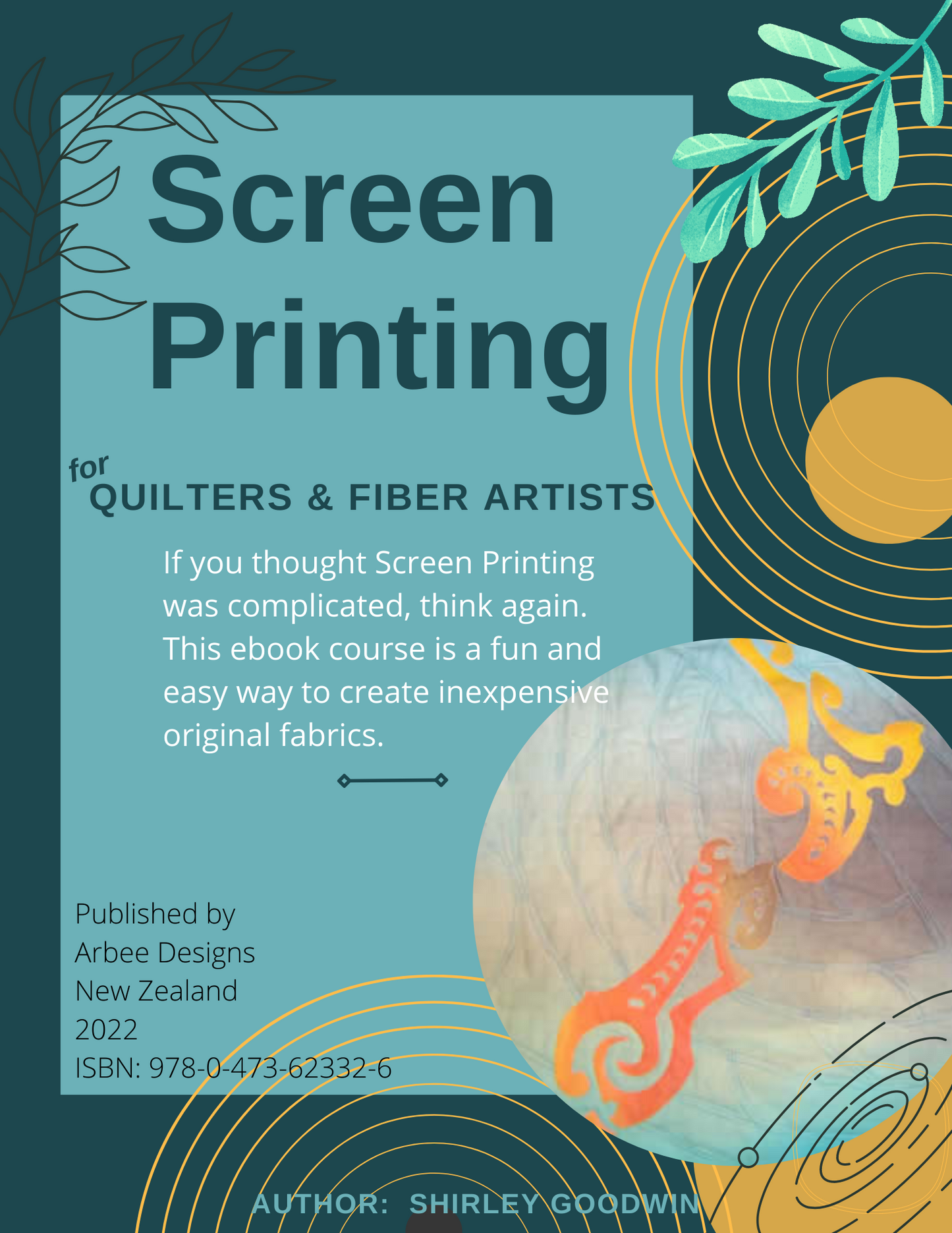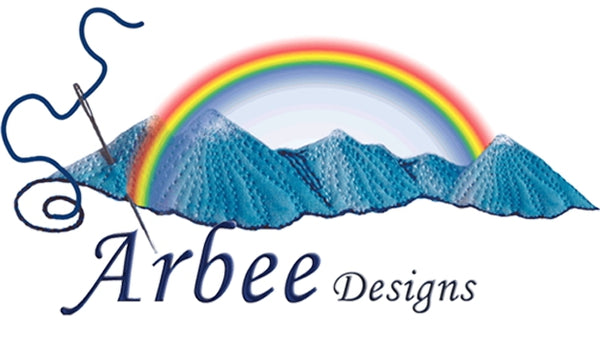
- Description
- Requirements
If you thought Screen Printing was complicated, think again. This ebook teaches you a fun and easy way to create inexpensive original fabrics. Create your own designs and discover the joys of being able to screen print your own fabric.
You will explore how screen printing can provide color and texture to your quilting and textiles without the need to use traditional methods. This is a fun and easy set of instructions suitable for all levels. Please note: This ebook is NOT about printing t-shirts and does not cover traditional commercial-type screen printing methods.
As an added bonus, when you purchase this ebook you will get two bonus tutorials too. One on how to make your own screens for screen printing and another one for how to make fabric paints.
Part ONE
- Preparing your workspace
- How screen printing works
- Making paper stencils
- Learning methods to apply paint
Part TWO
- Making more permanent stencils
- Positive/negative printing
- Words and letters
- Mixing colors
Part THREE
- Making resist stencils using interfacing
- Printing layers
- Making abstract screens
- Printing with household items
Part FOUR
- Color
- Making your own frames
- Printing yardage
- Printing onto clothing
- Discharge printing
Included a the bottom of this page is a number of Screen Printing Suppliers and a Glossary of Terms to refer to.
WHAT YOU NEED
- Screen 10” x 14” (minimum), 20’ x 24” maximum. You need to get a fairly coarse mesh, 8XX or 10 XX (32T or 42T in metric). (see notes below)
- Squeegee (see notes below)
- Paint (see notes below)
- Several newspapers to make a thick layer that you can cut and print on
- Around 1 yard/meter of cotton batting or felt to go over the newspapers
- Around 1 yard/meter of heavy cotton fabric (eg duck, canvas or similar) which will be the top layer - the printing surface
- An old china plate to lay your squeegee on
- Small plastic containers (I use yoghurt containers) to put your paint in
- Some plastic spoons for the paint
- Scissors (not your best fabric ones)
- Freezer paper for stencils
- Masking tape and duct tape
- A couple of cheap artist’s paintbrushes
- Mask-Ease or clear Contact (shelf) paper
- Some pieces of thin plastic the same size as your screen - you could use old plastic file covers, acetate
- 2 to 3 yards/meters of cotton fabric. You can use any plain white, dyed or colored fabric, any color, as long as it’s clean and ironed
- 3 to 4 yards/meters of white or muslin (calico in Australia & New Zealand), washed and ironed
- Several pieces of dark commercial fabric, any size
- Half a yard (meter) of medium weight sew-in Vilene (interfacing)
- X-Acto or craft knife
- Notebook and pen/pencil
- For cleaning screens - some mildly abrasive cleaning powder such as Ajax, and an old toothbrush or nail brush
NOTE ABOUT SQUEEGEES
There is no need to rush out and buy an expensive screen printing squeegee at this stage. You can use the small plastic scrapers available from auto parts or hardware stores; wallpaper smoothers; Bondo scrapers; or other plastic scrapers. Your squeegee needs to be small enough to fit inside your frame and stiff enough not to bend (and break) when you apply some pressure to it. One of my squeegees is a grouting tool used by tradesmen. Window/shower squeegees are not suitable.
NOTE ABOUT PAINTS
You will need at least 3 colors, and at least 4 oz per color. The primary colors are good, and I like to add a jar of white as well to make pastels. You can use transparent or opaque paints, but if you plan to use dark fabric as your background, you will need to use the opaque ones so that they’ll show up properly. Sometimes the paints are referred to as “inks” in screen printing, so watch out for that if you are buying online. You can use any paint that is suitable for textiles and fabric, however the paint you buy needs to be quite thick. Thinner fabric paints, such as Setacolor and Jacquard Textile paints, are not recommended as they are more difficult to control, try to avoid these. You could also use thickened dyes if you are familiar with this - however, this class does not cover dyes.
There are endless brand names, depending on which country you live in - I am using New Zealand paints that are not available elsewhere which is why I don't list them. Sometimes they are called paints, sometimes they are called inks - it's all the same thing. You can even use ordinary acrylic house paint, but that tends to change the feel of the fabric and harden it.
NOTES ABOUT SCREENS
The screens we’re going to use are made with a wooden frame, with mitered corners, and a polyester multifilament mesh stretched tightly over this. At one time, the screens were made with silk as this gave the best results, hence the name “silk screening”. There are different sized meshes for different types of screen printing, with very fine ones used to produce detailed work on paper, and more open mesh for fabric, such as we’re going to use. The mesh number, ie 12xx, refers to the number of threads per inch. This is divided by 2.5 to get the metric equivalent.
You may have a screen made from polyester monofilament instead of polyester multifilament. Here are the equivalent sizes :
Multifilament Monofilament Metric equivalent
8xx is the same as 80-90 is the same as 32-36T
10xx is the same as 110-120 is the same as 44-46T
12xx is the same as 120 is the same as 48T
SCREEN PRINTING SUPPLIERS:
USA/CANADA
- Prochem www.prochemical.com - for ProFab paints, fabric
- Dharma Trading www.dharmatrading.com - for paints, screen printing kits, fabric
- Dick Blick www.dickblick.com for paints, mask-ease, frames, squeegees
- Enasco www.enasco.com for squeegees, speedball paints, screen printing kits, mask-ease
UNITED KINGDOM
- Screenstretch http://www.screenstretch.co.uk - for everything but the paints
- George Weil http://www.georgeweil.com/ for frames, squeegees, paints
AUSTRALIA/NEW ZEALAND
- Eckersley’s http://www.eckersleys.com.au - for kits, paints, screens, speedball paints, squeegees
- Fine Art Supplies http://www.fasart.com/ - for paints
- CCG Industries http://www.ccg.co.nz - for paints, screens, squeegees, frames
These are a few known suppliers - there are many others.
GLOSSARY
Flooding/the flood - Lightly distributing the paint across the screen prior to making the print. The paint sits in the mesh at this stage.
Pull/pulling - the process of moving paint down or up a screen in order to make a print
Resist - something that is applied to a screen to stop paint from going through it. The resist can be all over the screen, or on parts of it.
Stencil - a paper or plastic layer containing a design that allows some paint through the holes
Stroking/the stroke - a pull that involves enough pressure to move the paint from the mesh onto the fabric, creating the print.
Thermofax screen - a commercially produced screen made from a photocopy of a design. Not covered in this class.
Well - the area at the top and bottom of your screen, on the inside, where the paint is placed.
- Choosing a selection results in a full page refresh.
- Opens in a new window.

